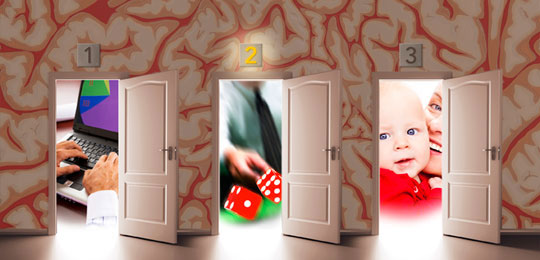Exploring the Marketplace of the Mind
By Jo Lynn Orr
It turns out that you may have a mind for economics—even if you can’t tell a Laffer curve from a bump in the road. Today many scientists are trying to understand how people make choices by viewing the human brain as a sort of marketplace, where each decision comes with a price tag reflecting its risks and rewards. This field of study is known as neuroeconomics, and it could help shed light on everything from consumer preferences to substance abuse.
Don Ross, Ph.D., is applying neuroeconomics to another form of addiction: gambling. Ross, a professor of economics and philosophy at UAB and professor of economics at the University of Cape Town in South Africa, explains that gambling can provide the truest model of addiction because it doesn’t involve a substance introduced from outside the brain. Most people who gamble don’t become addicted, of course, but some people find the experience so “rewarding” that it becomes obsessive. Ross and his research team are trying to find out what makes those addicted minds tick. “We’re interested in understanding how—independently of the whole person—that part of the brain that auto-processes reward stimuli does the computations that it does,” he says.
Ross shares his findings with UAB students in a regular undergraduate seminar on neuroeconomics, where he outlines the model of gambling addiction first presented in his book Midbrain Mutiny: The Picoeconomics and Neuroeconomics of Disordered Gambling, co-authored with Carla Sharp, Ph.D., David Spurrett, Ph.D., and UAB’s Rudy E. Vuchinich, Ph.D. As the book’s title suggests, the authors argue that addictive urges originate in the midbrain—the mind’s reward center, where values of alternative possible actions are compared.
Streams of Subconsciousness
One branch of neuroeconomics focuses on connecting conscious behavior with brain patterns—using technologies such as MRI to observe research volunteers as they make strategic choices. Ross’s investigations, however, follow another stream of neuroeconomics research. Essentially, this approach views the brain as much too complicated to be driven entirely by some sort of central, conscious system. “Humans don’t have access to most of what is going on in their brains, which must do all sorts of fast, subconscious processing in parallel,” Ross explains. “If brains couldn’t do that, then they would fail to cope with the demands of an environment that changes in real time. There are roughly 13 trillion points of information exchanged in your brain. There’s just no way it could function except with massive distribution and decentralization.”
As an example, take a look out the nearest window. You see one view—one unified, coherent image of the world—but “there’s a tremendous amount of backstage processing going on in identifiable parts of your brain that are computing hundreds of thousands of bits of data in order to deliver visual impressions,” Ross explains. He adds that a similar process goes on when we evaluate the potential rewards of decisions we face.
Ross and his colleagues in the second branch of neuroeconomics attempt to understand and model these mental activities—and that’s where the midbrain reward center comes in. “We know roughly the seat of these processes—the older mid-part of the brain we share with all vertebrates that is similarly structured in all mammals,” he says.
Model of a Malfunction
Addiction—of any type—“is a pathology of that midbrain machine,” Ross says. “The addict is someone whose brain has decided that it achieves its greatest reward from paying attention to cues for the consumption of one particular source of reward; it’s an inability to devote normal attention to cues for other rewards.” So the gambling addict, for example, finds it difficult to think about anything other than opportunities that will allow him or her to gamble. Anything else just can’t compete with the excitement that gambling provides.
Ross explains that the “malfunction really happens in the way the rest of the brain responds to the signals from that reward center. The midbrain is doing what nature designed it to do, but certain control mechanisms that normally keep it from driving all of your behavior have been crippled. So in some sense the machine is working properly, but the context in which it works has been disrupted.”
The ultimate goal for Ross and his colleagues is to present a unified model of addiction, using gambling addiction as its basis. “We want to write a mathematical theory of the computational profile of the dopamine circuit in the addict’s brain,” he says. The group is one step closer to realizing its goal now that it has collected the data from a national gambling prevalence study in South Africa involving 3,000 subjects. “We’re following 300 of those subjects over time and doing behavioral-economics experiments with them,” Ross says. “When we’re finished, we’re going to have the most comprehensive sample of observations of problem gamblers ever put together.”
More Information
Department of Marketing, Industrial Distribution, and Economics
